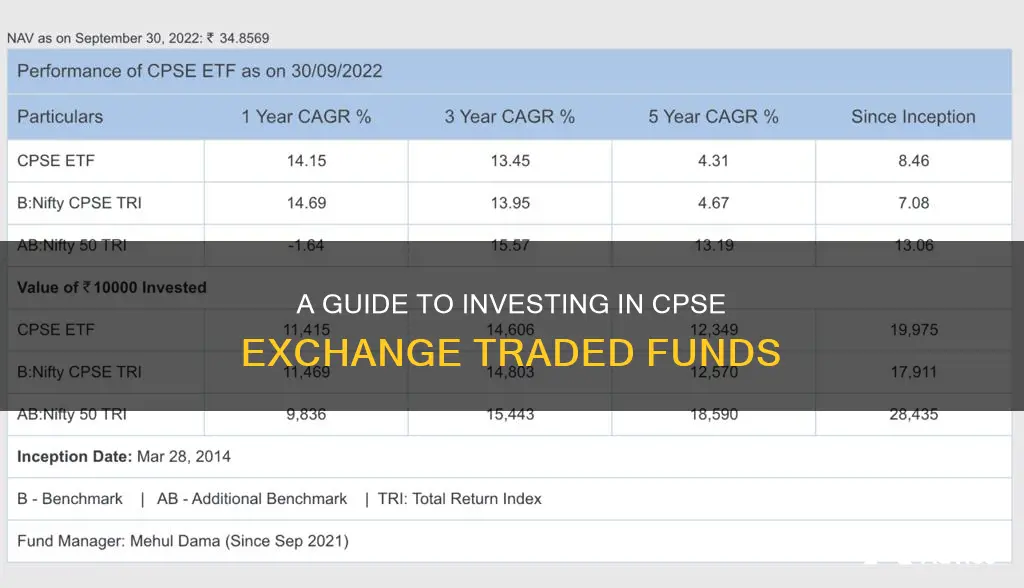
The CPSE ETF (Central Public Sector Enterprises Exchange-Traded Fund) is a unique financial instrument that allows investors to buy shares in a basket of companies owned and operated by the Indian government. This investment avenue is designed to provide diversification, cost-effectiveness, and transparency. By investing in a single CPSE ETF, investors gain exposure to a diverse range of public sector companies, reducing the risk associated with investing in a single company or sector. The CPSE ETF is a passively managed fund, meaning it aims to replicate the performance of a specific index, such as the Nifty CPSE Index, keeping maintenance relatively low. With no mandatory holding period, investors can trade units on stock exchanges, starting with a minimum purchase of one unit. This flexibility, combined with its low expense ratios, makes the CPSE ETF an attractive option for investors seeking long-term growth opportunities with stable returns.
What You'll Learn

Understanding CPSE ETFs
CPSE stands for Central Public Sector Enterprises, which are companies owned and operated by the Indian government. The CPSE ETF (Central Public Sector Enterprises Exchange-Traded Fund) is a financial instrument established by the Government of India to allow investors to invest in a basket of these public sector companies. This investment avenue is designed to align with the government's push towards disinvestment and public sector participation.
How CPSE ETFs Work
CPSE ETFs are passively managed funds that aim to replicate the performance of a specific index, such as the Nifty CPSE Index. The fund's portfolio tries to match the composition of this benchmark index, and the fund manager's role is to ensure that the ETF's performance closely tracks the index. This makes CPSE ETFs a relatively low-maintenance investment option.
Benefits of Investing in CPSE ETFs
Diversification
One of the most significant advantages of CPSE ETFs is the diversification they offer. By holding a basket of stocks from various CPSEs, the ETF spreads the investment risk across multiple companies and sectors. This diversification helps reduce the impact of poor performance from any single company, providing a more stable investment option compared to investing in individual stocks.
Low Expense Ratios and Cost-Effectiveness
Due to their passive management style, CPSE ETFs generally have lower expense ratios compared to actively managed funds. This cost-effectiveness allows investors to retain a higher proportion of their returns, making it an appealing choice for cost-conscious investors seeking long-term growth opportunities.
Liquidity and Tradability
CPSE ETFs are listed and traded on stock exchanges, providing investors with liquidity. Investors can buy or sell CPSE ETF units on the exchange at prevailing market prices during trading hours, giving them the flexibility to enter or exit their positions whenever desired.
Potential for Stable Returns
CPSE ETFs are composed of shares of established and well-known Central Public Sector Enterprises, which play a crucial role in India's economy. These companies often have a track record of stable performance and may distribute regular dividends to shareholders. Over the long term, CPSE ETFs have the potential to generate stable returns, especially when the underlying CPSEs perform well.
Factors to Consider Before Investing in CPSE ETFs
Risk Tolerance
CPSE ETFs are subject to market volatility and fluctuations, so it is essential to assess your risk tolerance before investing.
Investment Horizon
CPSE ETFs are generally more suitable for long-term investors, as short-term market fluctuations may not align with your investment goals.
Market Conditions and Government Policies
It is important to evaluate the overall economic climate and the performance of CPSEs in their respective sectors. Government policies, such as those related to disinvestment and economic reforms, can have a direct bearing on CPSE ETF performance.
Sectoral Exposure and Diversification
Understanding the sectoral exposure of CPSE ETFs and the potential for growth or decline in different sectors is crucial for making informed investment decisions. Diversification across sectors and companies within the ETF helps to spread risk and enhance potential returns.
TSP Funds: Where to Invest for Maximum Returns
You may want to see also

Advantages of CPSE ETFs
CPSE stands for Central Public Sector Enterprises, and a CPSE ETF is an exchange-traded fund that allows investors to buy shares in a basket of these government-owned companies. Here are some of the advantages of investing in CPSE ETFs:
Diversification Benefits: CPSE ETFs offer investors a diversified portfolio of major public sector companies across different sectors, reducing investment risk by not relying on the performance of a single company or sector. This diversification also helps to mitigate the impact of volatility that individual stocks may experience.
Low Expense Ratios and Cost-Effectiveness: CPSE ETFs are passively managed, meaning they aim to replicate the performance of a specific index without frequently buying and selling assets. As a result, the management fees and expenses of CPSE ETFs are generally lower compared to actively managed funds, making them an attractive choice for cost-conscious investors seeking long-term growth opportunities.
Liquidity and Tradability: CPSE ETFs are listed and traded on stock exchanges, granting investors liquidity. Investors can buy or sell CPSE ETF units on the exchange at prevailing market prices throughout trading hours, providing them with the flexibility to enter or exit their positions whenever they desire.
Potential for Stable Returns: CPSE ETFs are composed of shares of established and well-known Central Public Sector Enterprises, which have a substantial presence in the Indian economy. These companies often have a track record of stable performance and may distribute regular dividends to shareholders, offering the potential for stable returns over the long term.
Government Backing and Stability: The involvement of the Government of India in CPSEs implies a level of stability and reliability. This government backing can make CPSE ETFs a safer investment option compared to private sector investments, especially during market volatility and economic downturns.
Tax Efficiency: Investing in CPSE ETFs can offer certain tax benefits, such as tax advantages under specific government schemes. These benefits vary based on government policies and can enhance the overall returns of the investment.
Roth Funds: Where to Invest and Why
You may want to see also

CPSE ETF share price and performance influencers
The CPSE ETF share price and performance are influenced by various factors, including the fund's investment objective, portfolio composition, and underlying index tracking. Here is an overview of these factors:
Investment Objective
The CPSE ETF aims to provide returns that closely correspond to the total returns of the securities represented by the CPSE Index before expenses. This means that the fund seeks to replicate the performance of the index, which is composed of shares of government-owned companies or public sector undertakings.
Index Tracking
The fund employs a passive investment approach and is designed to track the performance of the Nifty CPSE TRI (Total Returns Index). This means that it aims to invest in the same securities that constitute the Nifty CPSE Index in the same proportion. However, there can be a tracking error, and the fund's performance may differ from the underlying index.
Portfolio Composition
The CPSE ETF's portfolio primarily consists of Large Cap stocks and debt instruments, indicating a conservative investment strategy. As per its mandate, the fund must invest at least 80% of its assets in the shares of public sector companies. As of 31-Jul-2023, the fund had invested 99.97% in equity, 0.03% in cash and cash equivalents, and 0% in debt. The top holdings include the Oil & Natural Gas Corporation and the Power Grid Corporation of India.
Share Price and Returns
The CPSE ETF's Net Asset Value (NAV) as of 21-Aug-2023 was ₹47.0010. The fund has delivered returns of 11.12% since its inception, approximately 9 years and 4 months ago. The share price can be influenced by various factors affecting the underlying securities and the overall market conditions.
Risk and Expenses
The CPSE ETF is considered a Very High-risk investment according to SEBI's Riskometer. The fund has an expense ratio of 0.05%, which covers various expenses such as management fees and service taxes.
In summary, the CPSE ETF's share price and performance are influenced by its investment objective of tracking the CPSE Index, its portfolio composition focused on government-owned companies, and the underlying index's performance. The fund's conservative investment strategy and expense ratio should also be considered when evaluating its potential returns and risks.
Navigating Investment Funds: Knowing When to Change for Success
You may want to see also

Risks associated with CPSE ETFs
As with any investment, there are risks associated with Central Public Sector Enterprises (CPSE) Exchange-Traded Funds. Here are some of the key risks to consider:
Market Risks and Volatility
CPSE ETFs, like any stock market investment, are exposed to market risks and fluctuations. The overall performance of the stock market can influence the Net Asset Value (NAV) of CPSE ETFs, leading to potential gains or losses for investors. Market volatility, driven by economic conditions, geopolitical events, and investor sentiment, can result in rapid price movements. Therefore, investors need to be cautious and consider their risk tolerance before investing in CPSE ETFs.
Sector-Specific Risks
CPSE ETFs consist of stocks from various sectors, and the performance of these sectors can vary based on industry-specific factors. For example, the energy sector's performance might be influenced by fluctuations in crude oil prices, while the banking sector's performance could be affected by interest rate changes and loan quality. Investors should be cautious about concentrating their investments heavily in one sector and should instead diversify across different sectors to mitigate this risk.
Government Policies and Regulatory Risks
Government policies and regulations can significantly impact CPSE ETF stocks. Decisions related to disinvestment, privatisation, economic reforms, or changes in sector-specific policies can affect the performance of the underlying CPSEs and, consequently, the ETF's returns. Additionally, changes in tax laws or investment regulations could impact the taxation of capital gains on ETF units, affecting investors' net returns. Staying informed about government policies and their potential implications is crucial for investors in CPSE ETFs.
Industry-Specific Risks
As CPSE ETF stocks are distributed across different sectors, the investment is vulnerable to industry-specific risks. For instance, an increase in crude oil prices can impact companies in the energy sector, while changes in interest rates can affect banking companies, ultimately influencing the ETF price.
Liquidity Risk
While CPSE ETFs offer liquidity due to their listing on stock exchanges, extreme market conditions or other factors could impact the liquidity of the investment. In times of high volatility or during specific market events, it may become challenging to buy or sell CPSE ETF units without impacting the price.
CEF Funds: Where the Rich Invest Their Money
You may want to see also

How to invest in CPSE ETFs
CPSE stands for companies owned and operated by the Indian government. The CPSE ETF (Central Public Sector Enterprises Exchange-Traded Fund) is a type of exchange-traded fund that allows investors to buy shares in a basket of these public sector companies.
Step 1: Research and Assess
Begin by researching CPSE ETFs and understanding their historical performance, portfolio composition, expense ratios, and risk factors. Evaluate whether investing in CPSE ETFs aligns with your financial goals and risk tolerance.
Step 2: Choose the Right CPSE ETF
There are different CPSE ETFs available in the market, so select the one that best suits your investment objectives. Consider factors such as the underlying CPSE companies, sector exposure, and expense ratios. Compare the options and choose the ETF that matches your criteria.
Step 3: Open a Demat Account
To invest in CPSE ETFs, you will need a Demat account. You can open an account with a stockbroker or a financial institution. Ensure that your Demat account is linked to your bank account to facilitate seamless transactions.
Step 4: Place an Order
Log in to your trading account and place an order to purchase CPSE ETF units. Specify the desired quantity of units and the price at which you want to buy them. CPSE ETFs are traded on stock exchanges, just like individual stocks.
Step 5: Monitor Your Investment
Once you have purchased CPSE ETF units, it is important to monitor their performance regularly. Keep an eye on market conditions and stay updated with any changes in the CPSE ETF portfolio that may impact its performance.
Additional Considerations:
- Diversification: CPSE ETFs offer diversification across various sectors, including energy, banking, power, and more. This helps to spread investment risk and enhance exposure to different segments of the economy.
- Expense Ratios: CPSE ETFs are passively managed, resulting in lower management fees and expenses compared to actively managed funds. This cost-effectiveness allows investors to retain a larger portion of their returns.
- Liquidity: CPSE ETFs are traded on stock exchanges, providing investors with liquidity. You can buy or sell units during trading hours at prevailing market prices, without any lock-in periods.
- Tax Implications: CPSE ETFs are treated as equity-oriented funds for tax purposes. Short-term capital gains are taxed at a flat rate of 15%, while long-term capital gains above a certain threshold are taxed at 10%. Dividends may also be declared, which are tax-free for investors, but the fund house deducts Dividend Distribution Tax (DDT).
In conclusion, CPSE ETFs offer a unique opportunity to invest in a diverse range of public sector companies. They provide benefits such as diversification, low expense ratios, and liquidity. However, as with any investment, it is important to conduct thorough research, understand the risks, and consult with a financial advisor to make informed investment decisions.
Unlocking Private Equity: The Power of Fund of Funds
You may want to see also
Frequently asked questions
CPSE stands for Central Public Sector Enterprises, which are companies owned and operated by the Indian government. A CPSE ETF is a type of exchange-traded fund that allows investors to buy shares in a basket of these public sector companies.
CPSE ETFs offer investors a way to diversify their portfolios by gaining exposure to a range of public sector companies across different sectors. They also provide cost-effectiveness, transparency, and liquidity advantages.
The performance of the CPSE ETF share price is closely tied to the combined performance of the underlying CPSE stocks. As an investor, you indirectly hold a portion of shares of all the companies included in the ETF's portfolio, enjoying the collective benefits and risks of those investments.
CPSE ETFs are treated like equity-oriented funds for tax purposes. Short-term capital gains are taxed at a flat rate of 15%, while long-term capital gains above a certain threshold are taxed at 10%. Dividends are tax-free for investors, but the fund house deducts Dividend Distribution Tax (DDT).
You can invest in CPSE ETFs through various platforms and stock exchanges, such as the NSE (National Stock Exchange) and BSE (Bombay Stock Exchange). You will need to open a Demat account with a stockbroker or financial institution and place an order to buy CPSE ETF units on the exchange.







